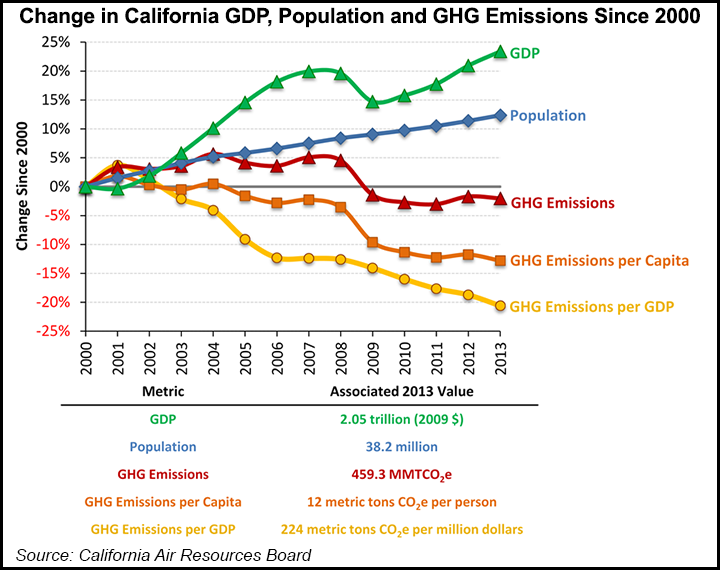Regulatory | NGI All News Access | NGI The Weekly Gas Market Report
California Air Regulators Set Draft Methane Rules; EDF Applauds Action
The California Air Resources Board (CARB) has released proposed regulations covering methane emissions and efforts to mitigate them, particularly in light of the three-month-old natural gas storage well leak in Southern California (see Daily GPI, Jan. 29).

The Environmental Defense Fund (EDF), which is spearheading a national effort with government and the industry to reduce methane emissions, called CARB’s move a “show of strong leadership to reduce greenhouse gas [GHG] emissions.”
“In light of the [Southern California Gas Co. (SoCalGas)] Aliso Canyon disaster, the case for strong national rules to limit methane pollution from both current and future oil/gas sites has never been clearer,” said Fred Krupp, EDF president, adding that the CARB proposed rules demonstrate something can be done now to lower methane emissions.
California’s Division of Oil, Gas and Geothermal Resources (DOGGR), which oversees the oil/gas industry in the state, has reviewed the draft CARB rules but did not provide any comments at this point, a spokesperson told NGI. “We’re also coordinating on leak detection, given that is a component of our emergency regulations [see Daily GPI, Jan 15].”
The draft regulations cover 67 pages, including appendices, and cover all the major segments of the oil/gas supply chain, including underground natural gas storage, and leak detection and repair. In the storage language an author’s note from CARB staff says the agency is considering including leak emission reduction requirements for any large or catastrophic leaks at oil/gas facilities covered by the regulations.
By Jan. 1, 2017, the draft rules would require each storage facility in the state, of which there are at least 12, to develop a plan for surface leak monitoring at the facility on a continuous basis, or at least daily, if 24/7 nonstop is not feasible. “[Each of the] plan[s] will be evaluated based on sensitivity of instrumentation, coverage of the facility, appropriateness for the site and other relevant criteria,” the CARB draft said.
For leak detection, the draft regulations would require by Jan. 1 that operators shall inspect components for leaks (audio-visually) at least once every 24 hours for facilities visited daily, or at least once a week for unmanned facilities. Also by next year, components must be inspected for leaks quarterly.
The draft rules also establish categories of leaks and prescribed time periods during which they must be repaired, ranging from five to 14 days to 180 days. There are also limits for leaks found among 200 or fewer components or a sampling of more than 200 components.
In the DOGGR draft emergency rules for storage, among the new requirements, which must pass muster with the state Office of Administrative Law (OAL), are:
EDF California climate initiative director Tim O’Connor stressed that the new draft rules are much needed given that the state’s oil and gas facilities are what he described as “old and decrepit.” With current technology for tracing methane emissions and fixing leaks, and the ongoing events at Aliso Canyon, “this long-awaited proposal [from CARB] for increased oversight and maintenance requirements couldn’t have come sooner.”
Methane rules are also being looked at on the national stage. As the Senate prepares to vote on a comprehensive energy reform bill as early as this week, a number of Senate Democrats are pushing the Environmental Protection Agency (EPA) to expand its proposed oil and gas methane emissions limits (see Daily GPI, Feb. 1).
Last week, a group of 21 senators, led by Sens. Brian Schatz (D-HI) and Sheldon Whitehouse (D-RI), penned a letter to EPA Administrator Gina McCarthy urging regulators to go beyond current plans to limit methane emissions from the oil and gas industry.
The senators wrote that they “strongly support many features” of EPA’s proposed methane rule, which would apply to new and modified sources in the oil and gas industry.
© 2024 Natural Gas Intelligence. All rights reserved.
ISSN © 1532-1231 | ISSN © 2577-9877 | ISSN © 1532-1266 |
